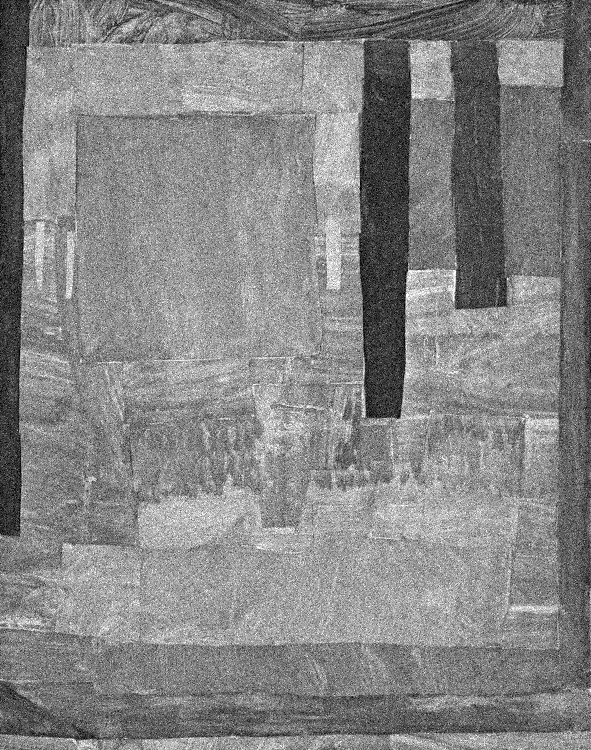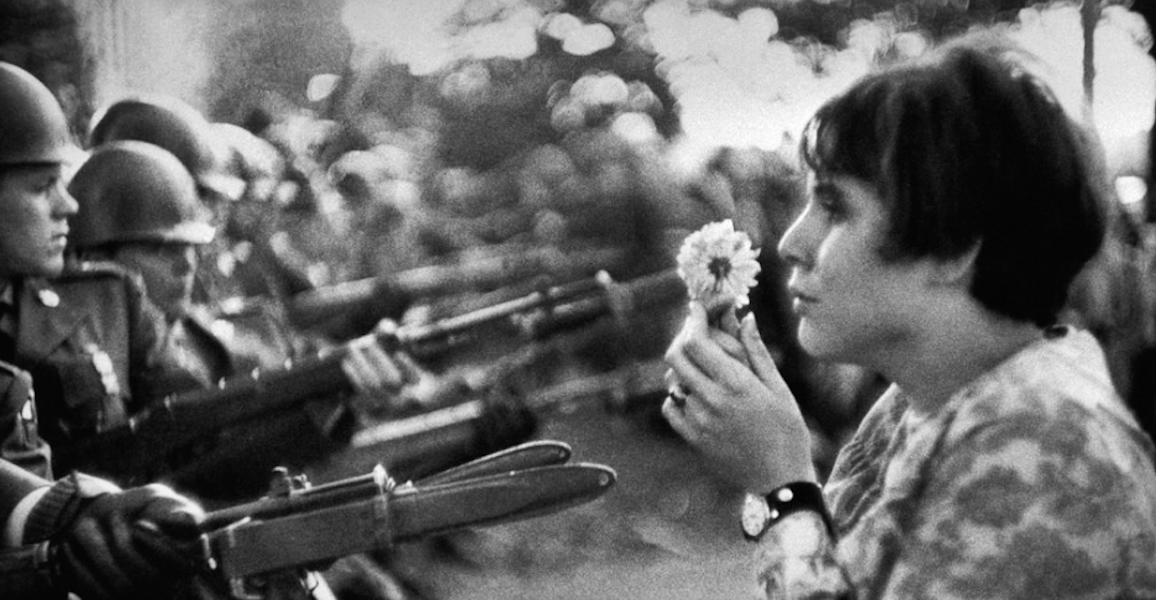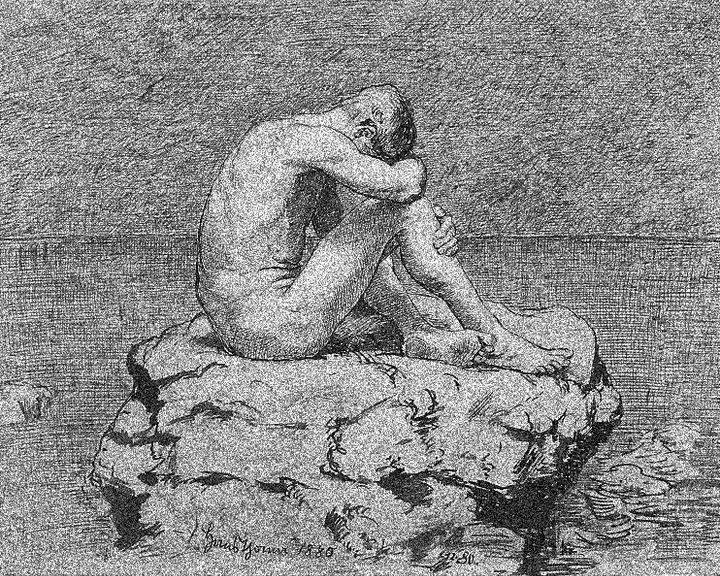Abbie Hoffman was a Disaster for the Left
Aaron Sorkin portrays Abbie Hoffman as someone we can learn from. The problem is that we’ve already learned too much from him.

So much of the Left’s response to The Trial of the Chicago 7 has had to do with the fact that it was made by Aaron Sorkin, whose general critique as a liberal ideologue—empty calories to be sure, but too satisfying to resist—is a favorite leftist pastime. The main criticism in this case is that Sorkin makes the bad guys too good and the good guys too “good.” On the one hand, the true evil at work in the trial is downplayed: for example, Bobby Seale was gagged and bound not for a few minutes, as depicted in the film, but for three days, and the prosecuting attorney, Richard Schultz, was not a reluctant public servant but an eager Nixon henchman. And on the other hand, the protagonists of the film are all domesticated versions of their real-life counterparts: Tom Hayden and Dave Dellinger were not goody two-shoes, Jerry Rubin was not an acid dunderhead, and Abbie Hoffman was much funnier and more incendiary than Sorkin depicts.
I want to bracket this question regarding the disjunction between Sorkin’s fantasy and reality, the rageful fixation on which might blind us to other questions here. I’m going to focus for the moment on the fantasy itself: if you’re the rare normie who stumbles upon this movie with no real knowledge of the historical context of the trial and no culturally leftist friends to regurgitate Twitter opinions to you, what moral are you likely to take from this film?
Besides the obvious clash between a reactionary Nixonian establishment and late sixties radicalism, the central conflict in the movie is between Tom Hayden’s “real” revolution and Abbie Hoffman’s “cultural” revolution. Hayden and Hoffman are at each other’s throats throughout the film, building to a climactic encounter when Hoffman demands to know, “What’s your problem with me, Hayden?” Hayden responds:
My problem is that for the next 50 years when people think of progressive politics, they’re gonna think of you. They’re gonna think of you and your idiot followers passing out daisies to soldiers and trying to levitate the Pentagon. So they’re not gonna think of equality or justice, they’re not gonna think of education or poverty or progress. They’re gonna think of a bunch of stoned, lost, disrespectful, foul-mouthed, lawless losers, and so we’ll lose elections.
As noted in the Chapo Trap House episode devoted to the film, this rant feels very much like Sorkin ventriloquized: the responsible electoralist chastising the Left for its symbolic buffoonery. But what happens next? It’s revealed that Hayden, in a fit of rage after seeing his friend Rennie Davis clubbed, “started” the Chicago riot by proclaiming to the assembled crowd, “If blood is gonna flow, let it flow all over the city.”
Hayden can no longer take the stand, so Hoffman does. To the viewer, it’s pretty clear that Hayden is wound way too tight. Between the hysteria of Hoffman and the obsessive-compulsiveness of Hayden, Hayden’s neurosis is revealed to be far more damaging: you hold it in too long, you internalize the role of “good boy” (demonstrated in one scene when Hayden unwittingly stands for the judge after the rest of the seven agree not to in protest), and you’re bound to crack.
Hayden’s redemption comes at the end of the film, when the judge allows him a few words before sentencing, warning him to keep his statement “brief and without political content of any kind.” With a raised fist from Rubin and an approving smile from Hoffman, Hayden proceeds to read the names of the 5000 American troops that had been killed in Vietnam since the beginning of the trial.
At a moment of political tumult and street protest, the lesson for good left-liberals couldn’t be clearer: sometimes you have to join the “cultural” revolutionists and engage in media-friendly symbolic protests. Sure, these symbolic protests might be “counterproductive” from the standpoint of electoralist number-crunching, but they are an essential safety-valve to let off a little (though not too much) steam. Far then from denigrating the Yippies in the film, Sorkin believes good, responsible liberals have much to learn from them. As Black Lives Matter protests helped the Democrats in letting off a little steam over the summer so that everyone could do the responsible thing and vote Biden in the fall, so too did Abbie Hoffman help Tom Hayden learn to loosen up a bit before launching a career as a successful politician. Hoffman thus emerges as an unwitting hero of the film, or at least someone who good political actors ought to respect.
Ok, enough Sorkin: let’s get to Hoffman the man.
Abbie Hoffman was a classic middle-class rebel: donning leather jackets and fighting teachers at his private high school before “radicalizing” under the influence of Herbert Marcuse at Brandeis. An East Village hippie looking longingly west, Hoffman was very impressed by what was happening out in San Francisco, even helping organize a New York City “Be-In” in 1967 modelled on its west coast prototype. Later that year, at an SDS-sponsored conference, he encountered the Diggers, a communitarian anarchist acting troupe based in San Francisco, and began calling himself “Abbie Digger.” His books were filled with rehashed Digger ideology, and the Diggers noticed. One of its founding members, Peter Coyote, later recalled:
Abbie, who was a friend of mine, was always a media junky. We explained everything to those guys, and they violated everything we taught them. Abbie went back, and the first thing he did was publish a book, with his picture on it, that blew the hustle of every poor person on the Lower East Side by describing every free scam then current in New York—which were then sucked dry by disaffected kids from Scarsdale.
After the New York Be-In, Hoffman teamed up with Rubin to stage an “exorcism” of the evil spirits of American imperialism. In October 1967, 75,000 protestors converged on the Pentagon with the aim of levitating it 300 feet in the air. As luck would have it, thanks to Peggy Hitchock (one of the Mellon fortune heirs), two hundred pounds of daisies were distributed to the protestors, resulting in some of the most iconic images from the sixties.
For Hoffman and Rubin, it was a resounding success. Said Rubin: “It made me see that we could build a movement by knocking off American symbols…. We had symbolically destroyed the Pentagon. The media had communicated this all over the country and lots of people identified with us, the besiegers.”
The event would solidify for the pair the overriding importance of the media. In a telling statement of the period, Hoffman declared himself “[a] modern revolutionary headed for the television station, not for the factory.” Media attention for Hoffman was not a component of a strategy; it was the end in itself, and the more he got, the more he wanted. This was the beginning of what we could call “stunt activism”: political action geared not to organizing new constituencies but to creating the right media buzz. They even dubbed their events “advertisements for the revolution.”
It’s relevant to mention here that the Youth International Party was in fact no party: it had no real membership and spoke for no constituency. It was simply the sum total of whatever Hoffman, Rubin, and other associated self-promoters did. In this, they also foreshadowed the top-down, NGOist advocacy work that would explode in the 70s and 80s. The Yippies never brought a professional sheen to their events—as Hoffman said of their meticulous organizing strategy, “[y]ou just get stoned, get the ideas in your head and then do ‘em”—but like their nonprofit heirs, they were focused more on propagating a dramatic and polarized “message” for which they sought an audience than advocating on behalf of an existing constituency.
This brings us to Chicago. When the Yippies planned for their “Festival of Life” to counteract the Democratic Party’s “Convention of Death,” they were thinking more about what kind of media response they could get rather than about what base they could mobilize. Their messages for months before the convention reached a fever pitch: “We will burn Chicago to the ground!”, “We will fuck on the beaches!”, “Acid for All!” The last was both a slogan and a threat: the Yippies let it be known that they intended to spike the water supply with LSD.
Undoubtedly Mayor Daley was wrong to use these fictive threats as reason to turn Chicago into a military zone. But all the polling done at the time indicates that the vast majority of the public approved of the Chicago police’s brutality toward the young protestors. You can chalk this up to misplaced fear or intergenerational rage, but it’s undeniable that the Yippies were but one self-important part of an embarrassingly minoritarian “movement.”
And though the Yippies would predictably brand “Czechago” a success—“Always declare victory,” another foreshadowing of the NGOist Left—the movement would only grow more subcultural and alienating from there, with “militant” groups like the Motherfuckers and the Weathermen taking up the mantle of fantasied insurrectionism. If anything, the Yippies found their real success not on the Left but in stoking the forces of reaction. As Todd Gitlin muses in his review of Sorkin’s film, “[t]hat the mayhem in the streets might help Richard Nixon win the coming election is not a thought breathed by anyone in the movie. But here the movie is true to life, for astoundingly, no one in the New Left was thinking that far ahead.”
That people would be justifiably angered at the disjunction between fantasy and reality in The Trial of the Chicago 7 makes enough sense. But the reality behind Sorkin’s film is nothing worth redeeming. Hoffman was not a “brilliant acid-head community organizer” who should be celebrated for his passionate commitment, militancy, and “guerrilla theater” antics. As Ben Burgis notes in Jacobin, Hoffman and company “devolved into playacting fantasies of armed revolution against one of the best-armed and most institutionally stable states that’s ever existed. They had neither the patience nor the ideological perspective to engage in the long, slow, boring work of organizing (or even orienting toward) the working class.” He goes on for some reason to praise “the admirable core of their commitment to a better world”, but the basic criticism still stands.
The Yippies were the progenitors of a media-centric stunt activism. They represented no constituency and confused personal self-promotion for movement progress. They prioritized dramatic confrontation with the “pigs” above mass politics. They were everything subcultural, impatient, unpopular, and organizationally thin about the Left before these became its defining features.
By all accounts, Abbie Hoffman was a charismatic, funny, and genuinely “cool” guy. But the Left does not need any more media-savvy grifters who trade in the symbolism of protest, and in fact we have a ways to go in muting the undue influence of self-promoting, cool characters. It makes sense why Sorkin wants to recover Hoffman for the present. Why the Left would want to do so is less clear.
■
James McDougall is a graduate student in political theory at the University of Chicago, where he studies the reception of Rousseau’s idea of amour-de-soi-même in Borneo between the years 1872 and 1874.




